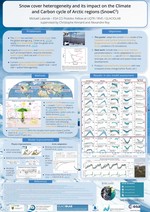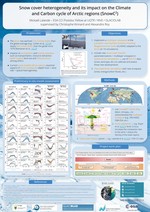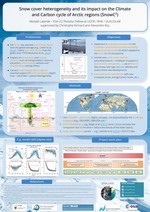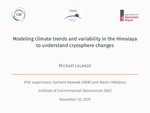2025
Colloque CEN 2025: Improvement of the CLASSIC Snow Model to Better Simulate Arctic Snowpacks
Current snow models – including the most sophisticated ones, such as CROCUS and SNOWPACK – struggle to properly simulate Arctic …
2024
CCI Colocation 2024: Snow cover heterogeneity and its impact on the Climate and Carbon cycle of Arctic regions (SnowC2)
CCI Colocation & CMUG Integration meetings 2024
CGU & COHERENT-C/CLASSIC workshop 2024: Snow cover heterogeneity and its impact on the Climate and Carbon cycle of Arctic regions (SnowC2)
2024 Annual Meeting of the CGU 2024 COHERENT-C/CLASSIC workshop Lightening Talk (COHERENT-C/CLASSIC) Poster (CGU + COHERENT-C/CLASSIC)
CLASSIC biweekly meeting: Snow cover heterogeneity and its impact on the Climate and Carbon cycle of Arctic regions
This talk describes the preliminary work intended to serve as a basis for the development of a multilayer snow model adapted for the …
Colloque CEN 2024: Snow cover heterogeneity and its impact on the Climate and Carbon cycle of Arctic regions (SnowC2)
One of the current limitations of the Canadian Land Surface Scheme including Biogeochemical Cycles (CLASSIC) is the use of a …
2023
ESA-CCI Kick-off meeting: Snow cover heterogeneity and its impact on the Climate and Carbon cycle of Arctic regions (SnowC2)
For more information see the project: SnowC2.
RIVE / ECCC CRD seminar: From ORCHIDEE to CLASSIC: improving the simulated snow cover heterogeneity and its impact on the climate
Two studies carried out during my PhD and my current 2-year postdoc project will be presented. The first study investigates climate …
2022
IGS2022: Adaptation of a snow cover scheme for complex topography areas
Snow cover strongly modulates the energy fluxes between the atmosphere and the Earth’s surface. Indeed, snow has generally a much …
IMC2022: Adaptation of a snow cover scheme for complex topography areas
With an average elevation of 4000 m, High Mountain Asia (HMA) and the Tibetan Plateau (TP) are hosting the third largest reservoir of …
EGU2022: Adaptation of a snow cover scheme for complex topography areas
Snow cover strongly modulates the energy fluxes between the atmosphere and the Earth’s surface. Indeed, snow has generally a much …
SnowHydro2022: Adaptation of a snow cover scheme for complex topography areas
Snow cover strongly modulates the energy fluxes between the atmosphere and the Earth’s surface. Indeed, snow has generally a much …
2021
Comite de Thèse - 2ème année
Modélisation de la variabilité climatique et de ses liens avec la cryosphère dans les Hautes Montagnes d’Asie
PEDALONS: neige
Paramétrisation de la couverture de neige prenant en compte la variation de topographie sous-maille dans LMDZ/Orchidée
Réunion chantier HMA : CMIP6 HMA paper
Climate change in the High Mountain Asia simulated with CMIP6 models
2020
Journée des Thèses 2020
Modélisation de la variabilité climatique et de ses liens avec la cryosphère dans les Hautes Montagnes d’Asie
Comite de Thèse - 1ère année
Modélisation de la variabilité climatique et de ses liens avec la cryosphère dans les Hautes Montagnes d’Asie
LMDZ for Regional Climate Studies
LMDZ for regional climate study : “cold bias” in High Mountain Asia (HMA)
PEDALONS: Zoom and Regional Climates
Modélisation de la variabilité et des tendances climatiques en Himalaya pour une meilleure compréhension de leurs impacts sur la cryosphère
2019
AGU2019: Convolutional Neural Networks for Estimating Atmospherically-forced Sea Level Variations
The variability of sea-level anomalies (SLA) observed by satellite altimeters combines two components: a forced component paced by the atmospheric variability, and an intrinsic and chaotic component emerging from the ocean itself.
OST/ST2019: Attenuating the ocean chaotic variability in altimetric observations: from band-pass filtering to machine learning
The variability of sea-level anomalies (SLA) observed by satellite altimeters combines two components: a forced component paced by the atmospheric variability, and an intrinsic and chaotic component emerging from the ocean itself.



























